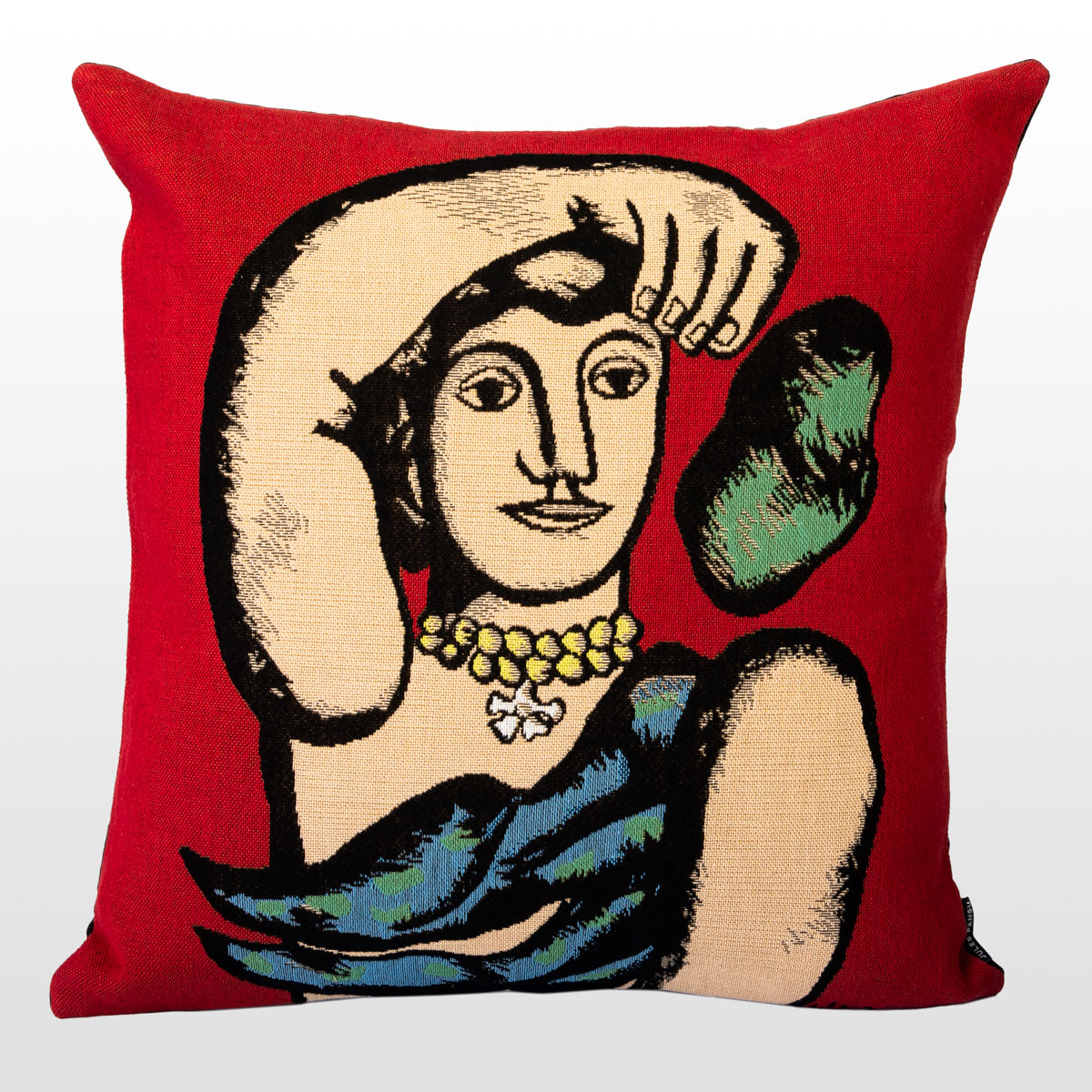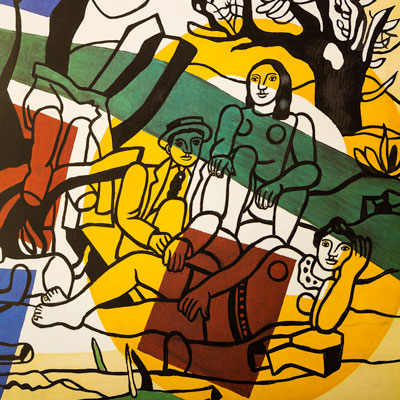Tel : (+33) 4 94 63 18 08
9am - 6pm from Monday to Sunday
All products Fernand Léger • Products of the topic Cubism
Fernand Léger Cushion cover : Lithographie Mourlot
REF : COUS-FL-02
In stock
Only 1 in stock
Unavailable
99,00 €
Fernand Léger Cushion cover : "Lithographie Mourlot"
Based on the work of Fernand Léger, with the agreement of Succession Fernand Léger.
In 2012, Jules Pansu was awarded the EPV label - Entreprise du Patrimoine Vivant - which rewards the excellence of French know-how. All our covers are made in France, woven on jacquard looms by two Best Workers in France.
Made in France
90% cotton, 5% Polyester
Dimensions : 45 x 45 cm
Cubism
The cubist movement in painting was one of the most important and influential artistic movements of the 20th century. It was developed by Pablo Picasso and Georges Braque from 1907, and expanded to include other artists such as Juan Gris and Francis Picabia. Cubism is characterized by the fragmentation of forms and the use of geometric lines and planes to represent objects in an abstract manner. Cubist artists also used a limited color palette and often incorporated African-inspired patterns and cubic forms in their works. Cubism had a significant impact on modern art and influenced many later movements, such as futurism and lyrical abstraction. It also had an influence on other areas of culture, such as architecture and fashion.
Discover the artist
Léger Fernand
Fernand Léger (1881-1955) was a French painter, sculptor, and filmmaker, who was one of the pioneers of 20th-century modern art. Born in Argentan, Normandy, Léger spent his childhood in Vendôme before moving to Paris to study art. He began his artistic training at the École des Arts Décoratifs in Paris in 1897, then studied at the Académie Julian in 1903. He also worked in the studio of architect Auguste Perret, where he was exposed to the philosophy of modern art and discovered the importance of functionality and technology in artistic creation. Throughout his artistic career, Léger developed a unique style that combined abstract forms and vibrant colors with an accurate representation of modern and industrial life. He was fascinated by technology and mechanization, and often depicted machines and industrial objects in his works. His work was also influenced by African art, which he discovered during a visit to the Trocadéro museum in 1907. Léger was one of the founding members of the Cubist movement, which revolutionized modern art by rejecting the traditional representation of perspective and using geometric shapes to represent objects. Over time, he developed his own Cubist style, which combined geometric forms with bright colors and organic shapes. During World War I, Léger was mobilized and served in the French army. He was wounded in 1916 and hospitalized for several months. This experience had a profound influence on his art, leading him to take a greater interest in social and political themes. In 1935, he was appointed professor at the Académie de la Grande Chaumière in Paris, where he taught until the end of his life. Fernand Léger died in 1955 in Gif-sur-Yvette, France.
Léger Fernand
Fernand Léger (1881-1955) was a French painter, sculptor, and filmmaker, who was one of the pioneers of 20th-century modern art. Born in Argentan, Normandy, Léger spent his childhood in Vendôme before moving to Paris to study art. He began his artistic training at the École des Arts Décoratifs in Paris in 1897, then studied at the Académie Julian in 1903. He also worked in the studio of architect Auguste Perret, where he was exposed to the philosophy of modern art and discovered the importance of functionality and technology in artistic creation. Throughout his artistic career, Léger developed a unique style that combined abstract forms and vibrant colors with an accurate representation of modern and industrial life. He was fascinated by technology and mechanization, and often depicted machines and industrial objects in his works. His work was also influenced by African art, which he discovered during a visit to the Trocadéro museum in 1907. Léger was one of the founding members of the Cubist movement, which revolutionized modern art by rejecting the traditional representation of perspective and using geometric shapes to represent objects. Over time, he developed his own Cubist style, which combined geometric forms with bright colors and organic shapes. During World War I, Léger was mobilized and served in the French army. He was wounded in 1916 and hospitalized for several months. This experience had a profound influence on his art, leading him to take a greater interest in social and political themes. In 1935, he was appointed professor at the Académie de la Grande Chaumière in Paris, where he taught until the end of his life. Fernand Léger died in 1955 in Gif-sur-Yvette, France.
Léger Fernand
Fernand Léger (1881-1955) was a French painter, sculptor, and filmmaker, who was one of the pioneers of 20th-century modern art. Born in Argentan, Normandy, Léger spent his childhood in Vendôme before moving to Paris to study art. He began his artistic training at the École des Arts Décoratifs in Paris in 1897, then studied at the Académie Julian in 1903. He also worked in the studio of architect Auguste Perret, where he was exposed to the philosophy of modern art and discovered the importance of functionality and technology in artistic creation. Throughout his artistic career, Léger developed a unique style that combined abstract forms and vibrant colors with an accurate representation of modern and industrial life. He was fascinated by technology and mechanization, and often depicted machines and industrial objects in his works. His work was also influenced by African art, which he discovered during a visit to the Trocadéro museum in 1907. Léger was one of the founding members of the Cubist movement, which revolutionized modern art by rejecting the traditional representation of perspective and using geometric shapes to represent objects. Over time, he developed his own Cubist style, which combined geometric forms with bright colors and organic shapes. During World War I, Léger was mobilized and served in the French army. He was wounded in 1916 and hospitalized for several months. This experience had a profound influence on his art, leading him to take a greater interest in social and political themes. In 1935, he was appointed professor at the Académie de la Grande Chaumière in Paris, where he taught until the end of his life. Fernand Léger died in 1955 in Gif-sur-Yvette, France.
Léger Fernand
Fernand Léger (1881-1955) was a French painter, sculptor, and filmmaker, who was one of the pioneers of 20th-century modern art. Born in Argentan, Normandy, Léger spent his childhood in Vendôme before moving to Paris to study art. He began his artistic training at the École des Arts Décoratifs in Paris in 1897, then studied at the Académie Julian in 1903. He also worked in the studio of architect Auguste Perret, where he was exposed to the philosophy of modern art and discovered the importance of functionality and technology in artistic creation. Throughout his artistic career, Léger developed a unique style that combined abstract forms and vibrant colors with an accurate representation of modern and industrial life. He was fascinated by technology and mechanization, and often depicted machines and industrial objects in his works. His work was also influenced by African art, which he discovered during a visit to the Trocadéro museum in 1907. Léger was one of the founding members of the Cubist movement, which revolutionized modern art by rejecting the traditional representation of perspective and using geometric shapes to represent objects. Over time, he developed his own Cubist style, which combined geometric forms with bright colors and organic shapes. During World War I, Léger was mobilized and served in the French army. He was wounded in 1916 and hospitalized for several months. This experience had a profound influence on his art, leading him to take a greater interest in social and political themes. In 1935, he was appointed professor at the Académie de la Grande Chaumière in Paris, where he taught until the end of his life. Fernand Léger died in 1955 in Gif-sur-Yvette, France.
Léger Fernand
Fernand Léger (1881-1955) was a French painter, sculptor, and filmmaker, who was one of the pioneers of 20th-century modern art. Born in Argentan, Normandy, Léger spent his childhood in Vendôme before moving to Paris to study art. He began his artistic training at the École des Arts Décoratifs in Paris in 1897, then studied at the Académie Julian in 1903. He also worked in the studio of architect Auguste Perret, where he was exposed to the philosophy of modern art and discovered the importance of functionality and technology in artistic creation. Throughout his artistic career, Léger developed a unique style that combined abstract forms and vibrant colors with an accurate representation of modern and industrial life. He was fascinated by technology and mechanization, and often depicted machines and industrial objects in his works. His work was also influenced by African art, which he discovered during a visit to the Trocadéro museum in 1907. Léger was one of the founding members of the Cubist movement, which revolutionized modern art by rejecting the traditional representation of perspective and using geometric shapes to represent objects. Over time, he developed his own Cubist style, which combined geometric forms with bright colors and organic shapes. During World War I, Léger was mobilized and served in the French army. He was wounded in 1916 and hospitalized for several months. This experience had a profound influence on his art, leading him to take a greater interest in social and political themes. In 1935, he was appointed professor at the Académie de la Grande Chaumière in Paris, where he taught until the end of his life. Fernand Léger died in 1955 in Gif-sur-Yvette, France.






























































































